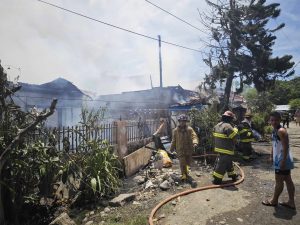Bicol has surpassed Davao as the fastest growing economy in the country for 2017-2018.
A data from the Philippine Statistics Authority (PSA) reveals that Davao tied with MIMAROPA (Southwestern Tagalog Region) for the second spot in the list topped by Bicol Region.
Bicol gained 8.9%, just a 0.3% higher than both Davao and MIMAROPA.
The Philippine economy dropped 6.2% from the previous rating of 6.7%.
Other regions that achieved higher than the 6.2% growth are Central Visayas with 7.6%, Cordillera Administration Region with 7.3%, Calabarzon (Southern Tagalog mainland) with 7.3%, Autonomous Region in Muslim Mindanao with 7.2%, Central Luzon with 7.1%, Northern Mindanao with 7.0%, SOCCSKSARGEN with 6.9%, Ilocos Region with 6.5% and Zamboanga Peninsula with 6.3%.
The National Capital Region (NCR) is among those areas in the lower bracket, getting only a 4.8%.
Other regions that gained lower than the national 6.2% rating include Western Visayas with 6.15, Eastern Visayas with 5.9%, Cagayan Valley with 3.3% and Caraga with 3.2%.
In a press conference yesterday on the 2018 performance of Davao Region Economy, it was revealed that the 8.6% for 2017–2018 is lower compared to 10.7% in the preceding year.
“Statistically, our growth is improving but it is decelerating. But if we consider the performance of the Philippine economy, it also decelerated from 6.7% to 6.2% for 2018,” National Economic and Development Authority (NEDA) XI Regional Director Ma. Lourdes Lim explained.
“Comparably with the other regions, our economic performance in Davao Region is relatively better and we have sound fundamentals as well,” Lim said.
The PSA data revealed that the services sector continued to account for the biggest share to the Davao region’s economy at 49.3%, followed by industry with a 40.1% share, and Agriculture, Hunting, Forestry and Fishing (AHFF) with 10.6% share.
Of the 8.6% economic growth in the region, industry is the major contributor with 4.3% followed by the services sector with 4.0% and AHFF with 0.3%.
“We still see construction – both private and public, and manufacturing sub-sectors as a major growth driver,” Lim said.
However, the growth of the industry sector posted deceleration from 19.0% growth in 2017 to 10.9% growth in 2018.
“Construction, the top contributor to the growth of industry, grew by 18.1% as compared with the 37.9% expansion in 2017. Mining and Quarrying expanded by 8.3%, slower than the 18.2% in the previous year. Manufacturing likewise decelerated to 6.4%, from 11.4% in 2017,” the PSA data said.
Only Electricity, Gas and Water Supply accelerated with 18.1%, from 3.8% in 2017.
According to Lim, the service sector is also contributor of the growth of the region.
“Service sector is also another growth driver in 2018 but we cannot also discount agriculture. But the services sector contributed to nearly half of our gross value added,” she said. This momentum for our services sector will still carry the bulk of our Gross Regional Domestic Product this year,” Lim added.
Services grew by 8.1% in 2018, faster than the 6.9% growth in 2017.
In the data provided, the top contributor to growth in services was the trade and repair of motor vehicles, motorcycles, personal and household goods which grew by 7.4%.
Meanwhile, sub-industries with faster growth include public administration and defense; compulsory social security, by 12.9% from the 6.5%; financial intermediation, by 10.4% from 6.2%; other services, by 8.3% from 3.8%; and transport, storage and communication, by 8.1%from 7.2% in 2017; while real estate, renting and business activities grew slower by 6.4% growth, from the 6.7% growth recorded in the previous year.
Agriculture Hunting Forestry and Fishing (AHFF) recorded a 2.9% growth, an acceleration from the 1.7% growth in 2017.
According to the PSA data, the Agriculture and Forestry grew by 3.5%, from 2.0% in 2017. Fishing declined by 7.0% from 3.6% contraction in 2017.





